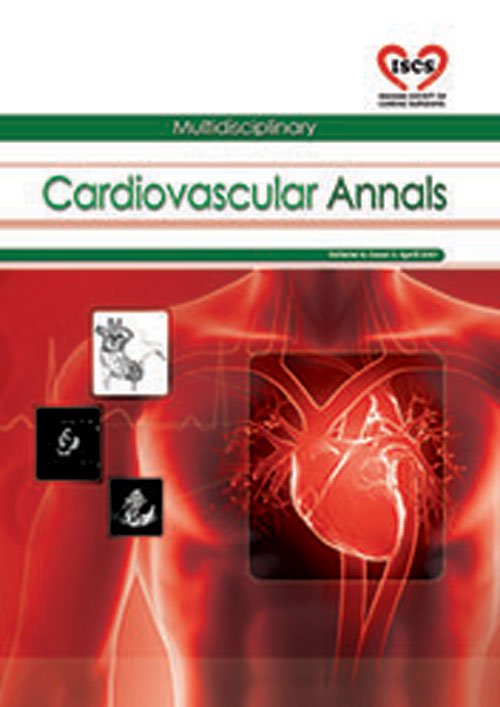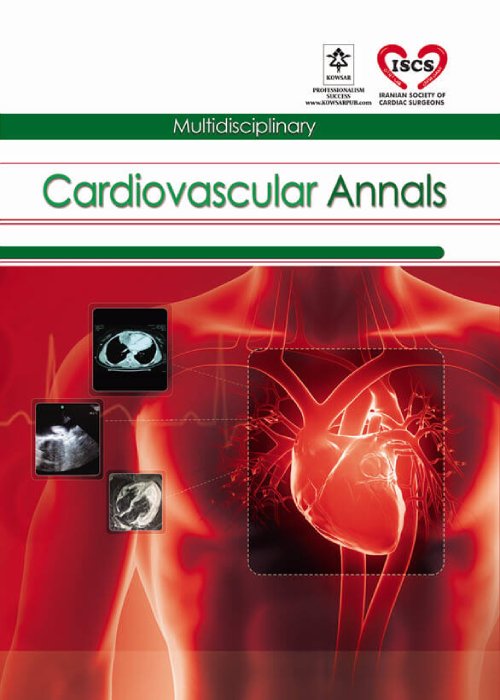فهرست مطالب

Multidisciplinary Cardiovascular Annals
Volume:10 Issue: 1, Jan 2019
- تاریخ انتشار: 1398/01/25
- تعداد عناوین: 7
-
-
Page 1Obstructive sleep apnea syndrome (OSAS) is the most common respiratory disorder related to sleep. It is characterized by recurrent upper airway obstruction episodes and hypoxemia attacks during sleep. Cardiovascular complications are rather frequent in OSAS. This compilation study aimed to show cardiovascular pathologies occurring during OSAS in detail and emphasize the need of treating OSAS during the treatment of these pathologiesKeywords: Obstructive Sleep Apnea Syndrome, Cardiovascular, Complication
-
Page 2BackgroundBronchopulmonary complications after CABG remain one of the main reasons for the increase in hospital mortality. A number of works showed the effectiveness of using PEEP-therapy and oPEEP-therapy in pulmonary pathology. However there was no direct comparison of the effectiveness of these methodic approaches in cardiac surgery patients.ObjectiveDue to this, the study objective was to study the effectiveness of recovery of respiratory parameters after coronary artery bypass graft using different device methods PEEP-therapy and vibration PEEP-therapy.MethodsWe studied 45 patients who underwent CABG. Patients were divided into 3 groups: Group I (control) - incentive spirometry was not performed after surgery, group II - PEEP-therapy was performed with EzPAP (USA), group III - oPEEP-therapy was performed with Acapella device (USA). Spirometry test was performed using device SMP-2101-RD (Russia).ResultsStudies showed, that on the second day post-surgery in groups I, II and III vital capacity decreases by 42%, 35%, 34% (P < 0.01), and forced vital capacity - by 46%, 32%, 35% (P < 0.01) respectively. In patients of all studied groups there is detected statistically significant decrease of PFER, AFER 25 - 75, MFER 25, MFER 50, MFER 75. On day five after surgery in the patients of second group vital capacity and forced vital capacity reached pre-surgery level, while in the group I these parameters decreased by 31% and 34%, and in group III - by 25% and 26% respectively. On the ninth day after surgery vital capacity and forced vital capacity in groups II and III reached pre-surgery level, while in group I these values remained decreased by 28%, 32%, respectively.ConclusionsCarrying out PEEP therapy after coronary artery bypass surgery with EzPAP incentive spirometer allows the restoration of volumetric and velocity respiratory values at the moment of patient discharge from the hospital, whereas after vibrational PEEP therapy the Acapella device restores only volumetric values, and in the patients of the control group, recovery does not occur.Keywords: Coronary Artery Bypass Grafting, Stress Spirometry, Respiratory Therapy, Spirography
-
Page 3BackgroundUric acid as an inflammatory marker has been hypothesized as a precursor of atherosclerosis and its role has been evaluated in recent studies.ObjectivesIn our study we wanted to assess its effect on the severity and extent of coronary artery disease in patients presenting to emergency department with acute coronary syndrome.MethodsIn this cross-sectional descriptive study, we enrolled all patients with ACS who attended to Shahid Rajaie Emergency Department from May 2016 to May 2018. All patients were sampled for their laboratory evaluation of serum uric acid and routine other lab tests. Besides, their traditional risk factors and medications were recorded and all patients underwent coronary angiography while their SYNTAX score was measured.ResultsTwo-hundred and six patients were included in our study in which 153 were male (74.3%) and the rest were female (25.7%). The mean age of all patients was 58.37 ± 10.48. From all traditional CAD risk factors, only hyperlipidemia had a direct relation with hyperuricemia (P value < 0.001). Inverse relation was demonstrated between LVEF and serum uric acid level (correlation coefficient -0.126 and P value = 0.047). Analysis also proved a strong relationship between the number of vessels involved and serum uric acid level and the higher serum uric acid level, the more vessels were involved (in SVD 5.29 ± 1.42 mg/dL, 2VD 5.81 ± 162 mg/dL, 3VD 6.14 ± 1.06 mg/dL and 3VD + LM 6.63 ± 1.70 mg/dL and P value = 0.004). Consequently, there was a significant relation between serum uric acid level and SYNTAX score (hyperuricemia prevalence in patients with SYNTAX score less than 22 was 15.8%, in the group of 22 - 32 SYNTAX score 28.6% and in patients with more than 32 SYNTAX score was 41.4% with P value = 0.007).ConclusionsSerum uric acid level measurement in patients presenting with acute coronary syndrome is both sensitive and efficient and could help in determining the patients’ general probability of atherosclerotic disease.Keywords: Serum Uric Acid, Coronary Artery Disease, Angiography, SYNTAX Score
-
Page 4BackgroundAlthough the TAVI technique has been widespread in Europe and America, concerns have emerged regarding the associated complications, mainly paravalvular leakage, vascular complications, stroke, post-operative pacemaker implantation due to complete AV block, optimal access sites, long-term valve durability, and economic sustainability, therefore controversy remains about the ideal treatment of high-risk operable patients. Sutureless tissue valves like Perceval S may be a good option for these high risk operable patients. We will present the clinical outcomes of first cases of Perceval S in Iranian patients.MethodsFrom July 2015 to August 2016, 11 patients (8 male, 3 female) with severe aortic stenosis who were candidates for aortic valve replacement were included in this study. The mean age of patients was 73 ± 8 ranged from 65 to 86 years. The most common presenting symptom was dyspnea and three of the patients had coronary artery disease in need for concomitant revascularization. Preoperative peak gradient across the aortic valve ranged from 72 to 135 mmHg (mean = 97 ± 25). All patients were followed up from 3 to 20 months with a median of 13 months.ResultsDramatic reduction of trans-aortic peak gradients was seen in all patient (mean postoperative gradient = 29 ± 8 mmHg). Small degrees of transvalvular and paravalvular leakage were seen in intraoperative echocardiographies but only one patient had small asymptomatic paravalvular leakage during midterm follow up. Two patients need for transient pace maker; however we had no case of complete heart block. Mean post-operative mediastinal bleeding was 480 ± 150 mL and no patient needed re-exploration for bleeding or tamponade management. ICU stay time was 3 ± 1.54 days, and there was no in-hospital mortality. All patients were discharged in good status and there was no mortality during follow-up period.ConclusionsPreliminary clinical results of the first experience was encouraging; however we need to continue the study with more study volume, more follow up period and more high risk or complicated patients.Keywords: Sutureless AVR, Aortic Valve Stenosis, Perceval S, TAVI
-
Page 5BackgroundCoronary arteries aneurysm (CAA) is one the rare and life-threatening abnormalities of the cardiovascular system.ObjectivesOur study aims to present clinical characteristics and surgical results of patients with aneurysm of coronary artery in Iranian population.MethodsThis is a retrospective case series of eight patients with aneurismal coronary artery, who underwent surgical repair in an Iranian tertiary referral centre from 2004 - 2014 and were followed up till 2017 (mean follow-up: 8.6 ± 3.8 years). Patients’ demographics, clinical characteristics, past medical histories and surgical data were recorded retrospectively. All data were analyzed by SPSS software (IBM Corp. IBM SPSS Statistics for Windows, version 22.0. Armonk, NY: IBM Corp.).ResultsOverall eight patients with CAA, consisting of 6 (75%) male and mean age of 35.21 ± 23.76 (0.75 - 67) years, were analyzed. Dyspnea and chest pain were the most frequent symptoms among patients (3 (37.5%)). Moreover, hypertension and coronary artery disease (CAD) were the most common comorbidities amongst our subjects. Angiography of patients showed concomitant CAD in 6 (75%) patients including four (50%) three-vessel disease and two (25%) two-vessel disease. Left anterior descending (LAD) was the most prevalent aneurismal coronary artery 4 (50%). Six (75%) patients underwent coronary artery bypass graft (CABG) at the same time due to coronary artery disease. One patient had post operative bleeding and underwent re-operation and 2 patients had pericardial effusion that didn’t require surgical intervention. There was no perioperative MI, respiratory problems, acute kidney insufficiency (AKI), infections and in-hospital or late mortalities in patients after surgery.ConclusionsMajority of patients diagnosed and treated for CAA, had concomitant coronary artery disease at the time of testing and underwent CABG. There were no peri and post-operative mortality, and all patients showed satisfying outcome. In addition to the benefits of early diagnosis and intervention in prognosis of patients, larger studies are warranted to identify the possible risk factors of this condition to identify those at risk in order to reduce the consequent complications.Keywords: Coronary Arteries Aneurysm, Clinical Characteristics, Coronary Artery Disease, Surgical Outcome
-
Page 6Danon disease is an X-linked dominant glycogen storage disease characterized by cardiomyopathy, skeletal myopathy, and intellectual disability. Danon disease has a rapidly progressive natural course, hence early diagnosis is crucial to achieve a proper management plan. This case concerns a 30-year-old male of Danon disease presenting with symptoms and signs of systolic heart failure, with no intellectual impairment and skeletal muscle involvement at presentation. Thus, he was initially misdiagnosed and managed as idiopathic sarcomeric hypertrophic cardiomyopathy. To the best of our knowledge, this is the first report of Danon disease in Iran, further implicating previous cases overlooked by local cardiologists.Keywords: Danon Disease Cardiomyopathy, Glycogen Storage Disease, Skeletal Myopathy, Heart Failure
-
Page 7IntroductionScimitar syndrome, a rare form of congenital heart disease (CHD), is characterized by anomalous pulmonary venous return into the inferior vena cava, hypoplasia of the right lung, and dextroposition of heart. The most common form of the syndrome known as infantile form, is diagnosed in infancy and is surgically corrected. Asymptomatic cases are occasionally diagnosed in adolescence. However, there are rare cases which remain undiagnosed until older ages despite some manifestations of the disease. This is in part due to the nonspecific nature of this manifestations which necessitates a specific workup for the diagnosis and treatment.Case PresentationWe report two cases of scimitar syndrome in female patients, one 17 years old and another 48 years old. Here we described the symptoms, diagnosis and clinical course of these patients and reviewed the literature on Scimitar syndrome particularly in adolescents and adults.ConclusionsAlthough Scimitar syndrome has early manifestations in most of the patients, its late diagnosis is sometimes seen in adolescents and adults due to misdiagnosis. Surgical repair can correct the blood flow route and improve the outcomes.Keywords: Scimitar Syndrome, Heart Defects, Congenital, Scimitar Anomaly, Multiple Cardiac Malformations, Craniofacial, Central Nervous System Abnormalities [Supplementary Concept], Pulmonary Veins


